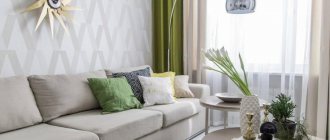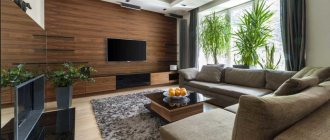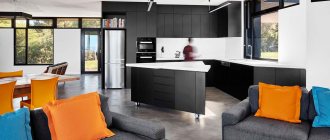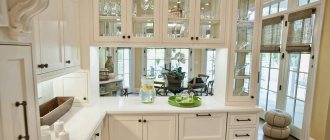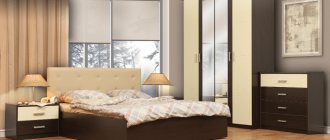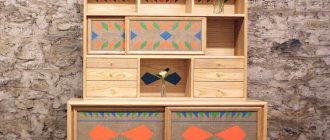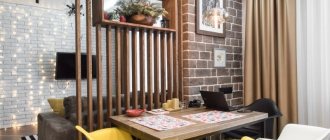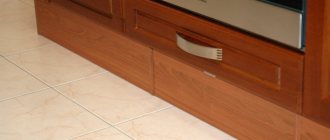Share on social media networks:
Having a certain number of original dishes, you don’t want to hide them, but put them on display for the guests, so to speak, share their beauty with the whole world. But it’s not always possible to arrange the dishes so that it looks like a composition and not an artistic mess. Typically, a “gallery” of services and glasses is located in a sideboard, so we will talk about them in this article. How to beautifully arrange glasses and wine glasses in a sideboard in the living room?
Sideboard and its place in our home
Sideboards first appeared in France in the 18th century. Only rich citizens could have them, since beautiful dishes in themselves were a luxury item. Accordingly, sideboards made of valuable wood were also available to a select few.
Antique sideboards
Ancient sideboards, like modern ones, consisted of two parts:
- the top one, in which there are shelves behind glass doors;
- the lower one is closed, with shelves behind doors or drawers.
Important! Sideboards quickly gained popularity. Having such a cabinet in the living room, containing exquisite dishes and crystal, was simply necessary to emphasize one’s status and boast of wealth. They were decorated with carvings, gilding, shaped forged handles, bent legs and elegantly decorated doors. They were made by hand, so they were all unique.
USSR cabinets
After a couple of centuries, a cupboard became a mandatory attribute of any European home. During the Soviet Union, this piece of furniture was in every apartment, but the appearance, of course, was not as pompous as its “brother” from the 18th century. It was rustic, laconic, one might say, minimalistic in design.
Such sideboards were produced by factories in huge quantities, but in appearance they all looked alike, like soldiers in the ranks. As we remember, mass production was inherent in everything - from clothing to dishes and vases. The interior of the apartments of average citizens was similar to each other.
A couple of decades ago, everyone was tired of sideboards, and it became unfashionable to have them in the apartment. But a little time passed and they were remembered again.
Our days
Now every self-respecting furniture manufacturer must have sideboards in their collection: simple and elaborate, wooden and plastic, standard and corner. Designers love this piece of furniture; it can be matched to any style of room. Moreover, modern cupboards are equipped with mirrored walls, lighting, and original fittings.
But in order for all this sophistication and originality to be appreciated, you need to know how to beautifully arrange dishes in a sideboard in the living room.
Important! For those who do not like the standard form of a sideboard, they produce ones that have a niche for a TV. The so-called “slides” for the hall are also sideboards in their own way, because in addition to shelves and a cabinet for TV and other equipment, there are display racks on the sides for dishes or books.
Practical storage furniture
Inside buffets, sideboards and other types of modern display cases, not only dishes are often stored.
Vintage living room with low cabinet with glass doors
Behind the glass cabinet doors you can also display beautiful figurines, awards, trinkets, bottles of elite alcohol, fragile interior items made of glass, crystal, etc. Cutlery and textiles (towels, napkins) are usually stored in closed compartments.
Such furniture can also become part of the furnishings of a home minibar.
Today, the offer of manufacturers is so huge that you can find on sale from the narrowest, low, miniature display cases for dishes to wide, three- and four-door ones.
What to fill the sideboard with?
What to put in the sideboard under glass instead of dishes? Each housewife has accumulated a considerable amount of sets, glasses, glasses and cups. And for myself, and for the dowry, and what was inherited from my beloved grandmother.
Everything seems beautiful, but is it necessary to display all the dishes in the sideboard?
- It is better not to display ceramic dishes and pottery. Find a place for them on open shelves in the kitchen if it is in Country or Provence style. And then, in small quantities. Better to stack them in a closed bottom section.
- A porcelain service, especially if it is rare or expensive, for example, Meissen, has the right to be located in a sideboard. But not in full force. A beautiful tureen, gravy boat, or salad bowl is enough. It is also better to place a pyramid of numerous plates downwards. You can place the largest dish vertically under the far wall.
- Tea sets are also not displayed in full. The teapot, sugar bowl, and milk jug are worthy of attention; you can supplement this group with a couple of cups and saucers. But such a service, of course, must be original and beautiful.
Important! Such compositions harmonize well with small trinkets: a napkin holder, small porcelain figurines, beautiful candles, tiny ceramic vases.
- Crystal will take its rightful place in the sideboard: glasses and glasses of different shapes and sizes. But they should stand separately from porcelain and ceramics. The crystal will play beautifully with all its faces if it is placed on a backlit shelf.
Important! Sometimes elite drinks or just drinks in unusual bottles are placed in the sideboard.
- What is undesirable to place in a sideboard are “towers” of heavy plates, bulky vases, photographs of numerous relatives, feathers, shells, mummified sea urchins and other souvenirs brought from resorts in memory of a vacation. Rows of identical glass glasses will also look ugly - it is better to hide them down, out of sight.
Types of display cases for the living room
Cabinets with glass - display cases in the living room can have not only very different designs, but also more than different shapes, sizes, configurations and designs. Not being a mandatory element of furniture, such an item acts more like a decoration, and therefore is decorated in a variety of ways.
Product design
First of all, modern and classic display windows in the living room are classified according to the type of construction. The following options are available.
- For a living room in a classic style - a wall display . The back wall of this design is usually blank; the side walls can be either closed or glazed. Since the facades are almost entirely glass, decorate the side walls or select spectacular fittings.
- The corner showcase for the living room is designed for installation in a corner and has a corresponding rear wall structure . As a rule, it is also deaf, but is usually finished with a mirror. A corner glass showcase in the living room can have a variety of shapes: triangular is the most popular and the most compact. The facade is completely glazed; this model practically does not need any additional decor;
- trapezoidal - this model has side walls; they can be either solid or glazed. A corner showcase in a living room of this type is more spacious and more functional;
- the radius option is the most effective solution. A rounded façade, especially a glass one, looks exceptionally chic. The cost of such a product is noticeably higher.
Corner display cases for a living room in a classic style can act as an integral element of a corner wall. In this case, the model also has side walls, but in cross-section it is a five-walled structure.
In the photo there is a corner display case between the cabinets.
- Modular - this type of furniture display in the living room is most convenient . All components of a modular living room are independent elements that, if necessary, can be assembled into a whole wall. The display case can stand independently or be a single unit with other cabinets.
- The classic version - a wall with a display case in the living room, is an integral complex . All its elements come together and cannot change position.
The photo shows showcases for the living room in a classic style.
- Full view model, or island showcase . In such a product there is no back wall as such. All the walls of the cabinet are glazed; the objects displayed in it can be viewed from all sides. As a rule, furniture is equipped with two doors on different sides.
- Built-in wardrobe - such display cases are installed in a bay window or niche . They are mounted in the same way as built-in wardrobes: shelves are fixed in a niche, and doors are made according to the size of the openings.
- A display cabinet with glass is less common in the living room . Although it can serve as an additional table, its height does not allow viewing the objects displayed in it. This is more of an option for storage than for display.
Classification by location
Showcases in the hall can be installed in different places. In accordance with this, furniture is divided into 2 categories:
- floor products - placed anywhere in the living room, either near the wall, in the center or in the corner, if it is a corner cabinet. This model does not require any additional fastening;
- hanging display cases for the living room - fixed to the wall and do not take up space on the floor. There are both small showcases of this kind and large ones - console ones. Thanks to this installation method, even a really large cabinet looks light and elegant.
The photo shows hanging display cases in the living room interior.
Dimensions and shape
For the living room, models of various shapes and capacities are made from solid wood, MDF, glass and even metal.
In the photo there is a wall with a display case in the living room.
Based on the number of valves and sizes, they are distinguished:
- The pencil case is a narrow, high design that takes up minimal space. They can be either island or modular;
- single door design - includes 1 door. As a rule, it is larger than a pencil case and is designed much richer and more interesting;
- a two-door display case in the living room is the most common option. Most often, such a structure has a buffet and a sideboard.
Modern technologies make it possible to produce wooden showcases for the living room in a wide variety of configurations.
On this basis they distinguish:
- a cabinet with smooth facades - they can be very interestingly designed, but a common feature is that the facade and walls are smooth planes;
- showcase with bent legs - most often this applies to a pedestal or display cabinet;
The photo shows a white showcase in a classic style in the living room.
- cabinets with an unusual configuration - due to the fact that some types of wood can be bent, decorative products such as display cases can have rounded shapes and smooth contours;
- radius showcases - while the facade itself can be curved, and the cabinet can have the most unusual shape. Moreover, now both glass and wood can be given the most amazing contours.
The photo shows a version of a beautiful display case in the living room.
How to properly place dishes in a sideboard?
Stylish arrangement of dishes in a sideboard, how to do it? There are several rules that will help you create a beautiful composition of dishes, and not assorted chaos. There may be many original items, but not all of them fit together. So, what rules should you follow when you decide how to beautifully arrange dishes in a sideboard?
Rule #1. Single style:
- Don't display everything you have in your bins. From the available sets and services, select those that most harmoniously combine not only with each other, but also with the color scheme of the room.
- Sets and services standing next to each other must be combined in functionality and the material from which they are made. Do not place crystal glasses next to the coffee set.
- Do not place figurines, vases and other small items next to crystal - place them only near ceramics and porcelain.
Rule #2. Observe the measure:
- You shouldn’t display everything from the services. Choose the most successful things: a salad bowl, a teapot, a milk jug, a fish dish, a couple of cups and saucers, and leave the stacks of plates at the bottom.
- Arrange items so that there is space between them and each item can be looked at.
- Place family heirlooms and items that are especially valuable to you in a place of honor - in the center of the composition, at eye level. But if there are a lot of them, choose a few, hide the rest for now. When you change the arrangement of dishes in the sideboard, replace them with others.
Rule #3. Harmonious arrangement of objects of different sizes:
- The arrangement of objects arranged from largest to smallest in steps looks tasteless. Divide the dishes into several groups and make a beautiful composition out of them.
- When arranging cookware elements, place the tallest ones closer to the far wall, and place the smallest ones closer to the doors.
Important! Don't know how to beautifully arrange glasses in a glass cabinet? Surround tall champagne glasses with crystal shot glasses.
Rule #4. Cabinet color compatibility:
- From all the sets of dishes, select for the sideboard those that will look most advantageous on the shelves.
Important! White porcelain and crystal will look chic in a dark wood sideboard. But in a light sideboard, bright dishes will sparkle with colors, but crystal and glass objects can look inconspicuous.
- Nearby compositions should also match in color. You can play beautifully with contrast.
Important! A red set will fit perfectly next to the ivory-colored dishes.
- Many people take into account the basics of Feng Shui when designing a sideboard. This teaching will find a place for every little thing so that its energy is directed in the right direction.
Style is everything
It is important not only to choose a stylish wardrobe for yourself, but also to take care of the “image” of the sideboard. The dishes placed in it should be harmoniously combined in terms of purpose and the material from which they are made. Crystal and ceramics cannot be placed together. Shot glasses, glasses and wine glasses are not suitable “neighbors” for tea sets.
If you have expensive dishes, but you practically never use them, it is not rational to take up space with them in the sideboard. It’s better to put there what you use every day. This will simplify the process of setting the table, and there’s no point in hiding luxury dishes behind glass.
Sideboard in the living room
Important! Dishes should be combined not only in quality and purpose, but also in cost. The photo shows how you can stylishly and neatly place plates, cups, and gravy boats in a sideboard with glass doors.
Video material
A sideboard is a fairly common piece of furniture, but, unfortunately, not all housewives know how to make good use of the space on its shelves. In order for this item to decorate and complement the interior of the room with its appearance, you must know how to beautifully arrange the dishes in the sideboard in the living room. Useful recommendations from this article will help you understand this matter and prevent the most common mistakes of incorrect placement. You can safely arrange the dishes on the shelves as your taste dictates. The main thing is to remember that a sideboard is an island of graceful beauty in your living room, and not a storage unit for rows of glasses, shot glasses and plates.
Beautiful and stylish piece of furniture
A showcase made of solid expensive wood, silverware and crystal glasses sparkling behind the glass - in a living room with a traditional, luxurious design, such a cabinet can become one of the main decorations.
On the shelves you can place memorable figurines and collectibles, which will now always be in sight.
In modern design, the cabinet can be made in bright colors, which allows you to create interesting contrasting color schemes.
How to choose the right one
The first thing you need to do is decide how much space you need to install the cabinet. Next, it is important to decide what kind of dishes will be located inside. Having collected the necessary information, pay attention to these tips to help you choose a display cabinet:
- dimensions of the room - standard ceilings in a city apartment rarely exceed 2.5 m. This should be taken into account when planning the product. The optimal height of the cabinet is from 1.5 to 2 m. You should not clutter the room with things when creating a furniture warehouse - it is better to leave some free space;
- type of glass. Before choosing, ask the seller about what kind of glass is used in the cabinet. Give your choice only to hardened surfaces. Ask to demonstrate a certificate of quality and compliance for durability. If the dishes are too heavy, ordinary glass will not be able to withstand the load;
- fittings – high-quality furniture is always equipped with durable fittings. Pay attention to the drawer handles, openings in the glass for opening, hinges and mechanisms;
- lighting - if the model is too large, choose options with built-in lighting. This move makes the product and the room modern. Don't forget to take care of the proximity of power sources;
- style - furniture showrooms offer models of modern and classic styles. Scandinavian, Baroque, Empire, Art Nouveau - they are all presented in a wide variety.
By deciding to get a display cabinet, you can significantly diversify the appearance of your living room. Models give the room completeness, it begins to play with new colors.
Construction and design of classic sideboards
The design of the sideboard resembles a table buffet. But, unlike a buffet, a sideboard can consist of several sections, each of which is designed to store certain things.
In its classic embodiment, a sideboard is a piece of furniture, conditionally consisting of two elements:
- upper body with glass doors;
- bottom chest of drawers.
The world's first sideboards were made exclusively from precious wood. The fashion of the 18th century demanded ornateness, sophistication and pretentiousness, so sideboards were often decorated with complex carved elements, gold plating, curved legs and rich fittings. At the same time, the sideboard could be made either in the form of a single structure or in the form of two independent elements - a massive wide chest of drawers and an elongated high display case. The chest of drawers, as a rule, was equipped with shelves or drawers in which housewives stored kitchen utensils or textile items. As for the display case, its space was divided by shelves into several sectors, thanks to which it was possible to place a lot of tableware and porcelain items.
Beautiful sideboards for dishes in the living room photo
Sideboards for the living room
Another difference between a sideboard and a buffet is the presence of doors. If the upper part of the buffet can be open, then the sideboard showcase, as a rule, was equipped with doors with glass elements. Depending on the shape and design features, this piece of furniture could have one, two or several doors, which were often complemented by wooden frames, doors and decorative details.
Sideboard for dishes photo
Despite the fact that the sideboard was originally created to store dishes and cutlery, this piece of furniture could be placed not only in the kitchen or dining room, but also in any other room. For example, the interior fashion of 18th-century France made it possible to place a sideboard in the most prominent place in the living room or reception hall.
Sideboards for the living room photo
In our open spaces, the sideboard gained popularity in Soviet times. But since at that time people preferred maximum simplicity and conciseness, the design of this piece of furniture was greatly transformed. The facade of the Soviet sideboard was not decorated, but was carefully cleaned and polished, which is why the product began to look like a kind of cupboard.
Sideboards for the living room photo
Sideboard for dishes in the living room photo
It may seem that a sideboard is purely decorative furniture, which is used in modern designs only to add additional style. However, this is not only a beautiful, but also quite functional item that allows you to organize a convenient storage system for things and utensils.
Modern sideboard with wine compartments
Sideboard display for the living room
Display of luxury tableware and handmade designer tableware.
Expensive dishes (often porcelain, crystal) and designer dishes made from a variety of materials require a boutique approach to display. Stores with such goods, as a rule, are well renovated and equipped with professional trade lighting to create light and color accents. Here the role of color, design and materials of commercial equipment increases.
The main principles of a boutique approach to displaying luxury tableware and designer tableware.
- The display is strictly collectible. Moreover, collections can be placed either in a single display area or along the rack (an entire rack can be dedicated to one single collection and additional additions to it).
- The display environment must emphasize the positioning, idea, and values of the brand as much as possible. The fact is that in the premium tableware segment there can be both truly luxurious and royal products with real gilt, and super-modern designer items made from innovative materials - the environment should be completely different.
- Monitor the contrast of the environment to the product - all the buyer’s attention is ONLY ON THE PRODUCT!
You will definitely need:
- Both open display cases and glazed display cases for displaying the most exclusive and expensive collections and services. The level of design and execution for commercial equipment must be consistent with the product—extra class.
- Custom (made to order for you using an exclusive design) island displays for the compositional display of expensive tableware. Sometimes antiques are used for compositional display—tables in particular.
- There must be very high-quality stands for plates, as well as stands for stepped, multi-level display. It is ideal to purchase transparent ones.
- Be sure to organize directional spot lighting. Pay attention to the lamps, the shade of the light and the direction of the lighting. this is super important for crystal and makes a difference for porcelain. The design of lamps must correspond to the image of your products. Sometimes you need to hide the lamps, and sometimes you need to order a creative design and present it with the product.
- Accessories that may be included in the range. Tablecloths, napkins, kitchen textiles of other typologies, souvenirs, interior items - all this must sell the dishes + be sold in addition to the dishes.
Here are a few photos of high-quality display of expensive and designer tableware.
Here is an example of how designer glasses, plates and glass damasks are arranged.
What is the color of the glass? Transparent, white. So that the buyer can immediately become interested in the product, black metal shelving with a plexiglass back wall, again black in color, was purchased.
All product units are at a glance.
And this is colored glass on a light background - contrast is simply necessary to sell such products.
An example of how a product should be displayed to show its value and quality. Pay attention to the equipment (contrast with the product and high quality workmanship), as well as directional lighting. Even the matting on the floor says, “You, buddy, are in a special store! Our dishes are special! It's time to fork out) "
Look how the lighting SATURATES the ceramics!!! The goods are literally burning from the inside! The eyes look only at them!!!
And this is a display of designer ceramic tableware.
This is a collection. Since the outer side of the dishes resembles sea shells - rough, the manufacturer puts the product in the public domain - touch, feel and fall in love...
And this is designer porcelain, but with a different brand idea. By the way, in the store, global zoning is based on designers - like in an expensive clothing boutique) And look at how the lighting in the niches is made. And the compositional layout in the center is simply incomparable - strict, stylish, nothing superfluous.
Display of kitchen utensils.
At eye level there is a stand with a detailed description of the collection - advantages, composition. right there the cost. Look at the equipment - it emphasizes the quality, traditionality, and solidity of the dishes.
Here is an example of how expensive kitchen textiles are organically combined with luxury tableware. You can also see the design of the compositional display in the center - solid, reliable, traditional, confident.
A wonderful example of the compositional display of dishes, vases, and napkins.
An example of displaying a piece of collectible goods in a glazed display and in a non-glazed display. For the most expensive dishes - elite porcelain, crystal - it is useful to create an ocher-golden environment with soft light.
Here are a few examples of how to display designer tableware.
Usually it is produced in tiny quantities and the display design must be appropriate.
I also give an example of laying out designer tableware in a modern style.
Pay attention to the design of the retail space, how organic everything is and fits perfectly with the brand. You immediately understand that this is very high-quality tableware for extraordinary people who are demanding about the environment, the level of design, and functionality. In the center is a well-organized display with cutlery.
If there is a sideboard with a transparent door in the kitchen or dining room, then it will be the second most important piece of furniture, after the table. Therefore, it will influence both the style and mood of the room. From a practical point of view, you should decide whether it will only hold holiday dishes or everyday plates. Whatever your choice, we will inspire you to create a true masterpiece.
Let's start with items for every day. If beautiful dishes are rarely used in the dining room, then it may be worth putting them in a box and putting them away, and filling the cabinet with things you use every day. Plates, mugs and glasses that are always at hand will simplify table setting, and behind the glass of the sideboard they will look no worse than beautiful models. The lower drawers are useful for storing cutlery and napkins.
To make an everyday look more festive, you can place vases of flowers or candles on the shelves, especially if they are open. They will enliven the interior and decorate the table.
If the choice fell on dishes for a special occasion, then you can admire them, and closed cabinet doors will protect them from dust. If there are more items in the set than can fit into the sideboard, then you shouldn’t cram everything in there. Arrange what you can beautifully, and put the rest in drawers.
Some things should be put up and some things should be put down. It is better to place large plates vertically, so that it rests on the wall. If you feel like a plate might fall, you can secure it with a stack of others.
For everyday dishes, this rule also works - a large dish can be placed between the sideboard wall and cups or plates.
If you stack similar items, you can not only save space, but also give your closet a stylish look. Cups, gravy boats and cake stands look good this way.
In the case when all the plates for cakes are stored in one place, it is worth thinking about other items that are required mainly during the holidays. For example, cake candles can be placed in a cup, drinks can be placed on one of the shelves, and flower vases can be placed on the other.
If you hang the most beautiful item from the set, you can not only stylishly update the interior of the room, but also save some space. The main thing is to look at the places on the shelves before driving a nail into the wall to determine the correct location.
The glasses should be lined up like soldiers on parade - evenly, clearly and neatly. For each type you need to allocate its own shelf, and not mix them.
A little contrast will add interest to the entire room. If you use white plates, then consider a black sideboard. The dishes will stand out against a dark or bright background.
Even if only the interior decoration of the cabinet is contrasting, the dishes will immediately look completely different.
If after arranging there is little space left, you can add pleasant dynamics with the help of other objects. For example, a combination of plates and books or an unusual painting would be interesting.
Even in the living room, such a piece of furniture would be appropriate if you give it the desired effect - for example, combining dishes and vases.
You can approach the sideboard from the other side and fill it with books, which will look amazing behind the glass door. Moreover, the more books, the better.
When in doubt, always stick to symmetry. To prevent this arrangement from being completely boring, you can add some interesting candle or vase to the dishes.
Categories: Places:
Watch a video about the site
Welcome to our kitchen design resource! We have created a collection of unusual and attractive kitchen interiors and decor ideas to decorate your home.
Categories
Select tags Accessories (95) Uncategorized (5) Kitchen decor (36) Designer kitchens (79) Kitchen interiors (219) Kitchen sets (60) White kitchen (39) Green kitchen (9) Classic style kitchen ( 15) Scandinavian-style kitchen (18) Modern-style kitchen (18) Country-style kitchen (13) Loft-style kitchen (4) Minimalist-style kitchen (11) Provence-style kitchen (6) High-tech kitchen (3) Metal kitchen (7) Black kitchen (11) Kitchen with island (57) Kitchen furniture (213) Furniture factories (18) New kitchen design ideas (91) Kitchen organization (91) Original kitchen tables (29) Kitchen Lighting (31) Kitchen Design (148) Kitchen Fixtures (55) Expert Kitchen Design Tips (68) Kitchen Style (154) Countertops (70) Kitchen Chairs (31) Kitchen Appliances (88) Backsplashes (58) Kitchen Photos (76) Kitchen Color (132)
Whether the kitchen is small or large, smart storage can make it super convenient and make your kitchen cabinets, pantry and refrigerator spacious. In this material you will find 17 practical tips and 85 photo ideas that will help you organize your space from scratch or optimize an already established “system”.

